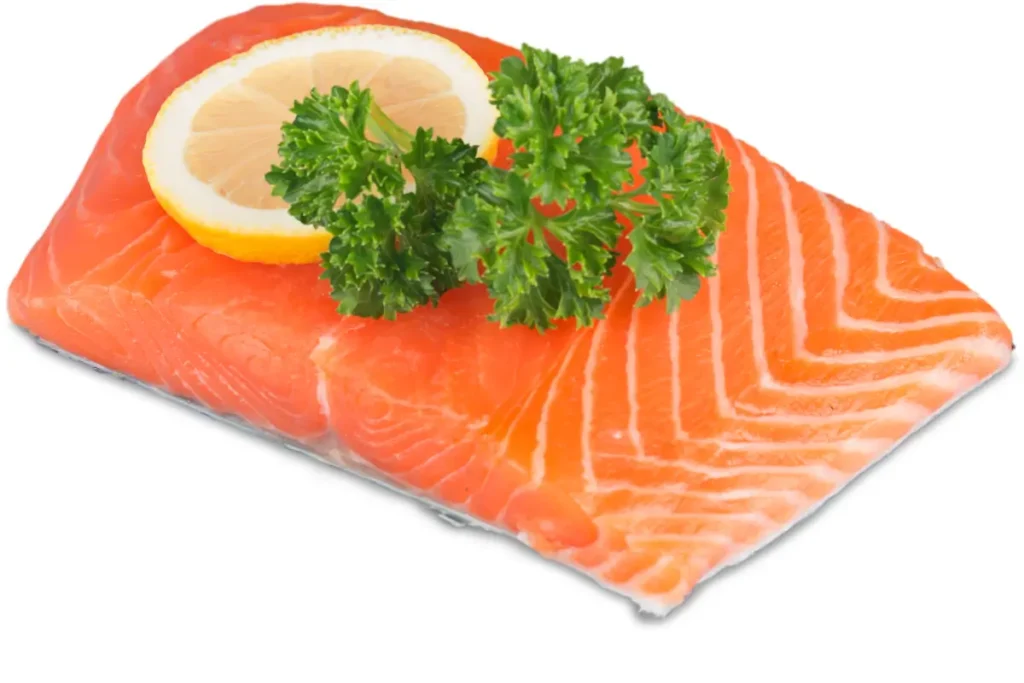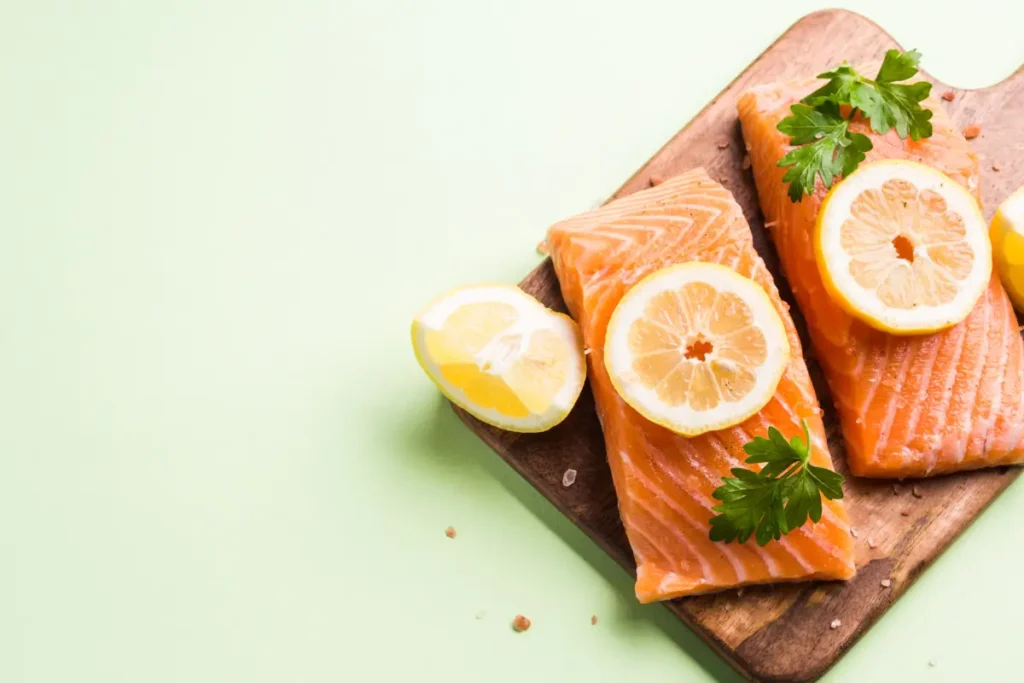
Introduction
Diving into the culinary world of seafood, a question often surfaces—“Can you eat salmon flakes raw?” This query isn’t just about taste preferences; it’s about exploring the realms of nutrition, safety, and culinary innovation. In this comprehensive guide, we’ll unravel the mysteries surrounding raw salmon flakes, offering insights into their health benefits, safety precautions, and delectable ways to enjoy them. Whether you’re a seasoned sushi aficionado or a curious foodie, this article promises to equip you with the knowledge to safely and delightfully incorporate raw salmon flakes into your diet, enhanced by insights from Grilled Salmon Salad: A Symphony of Flavors and Nutrients, which showcases the versatility of salmon in dishes.
Can You Eat Salmon Flakes Raw?
Absolutely! Eating salmon flakes raw is not only a culinary delight but also a practice embraced in various cultures around the world. However, it’s not as simple as picking any salmon off the shelf. The key lies in ensuring the salmon is suitably prepared and sourced for raw consumption. This section delves into the prerequisites for enjoying raw salmon flakes without compromising on safety, with Is Flaked Salmon Cooked? providing further clarity on how to differentiate between raw and cooked salmon, ensuring your culinary adventures remain both safe and enjoyable.
When considering raw salmon, it’s crucial to understand the difference between just any salmon and those specifically marked as safe for raw consumption.
Freshness, source, and preparation method are crucial factors that determine if you can savor salmon flakes raw.
Let’s embark on this flavorful journey with an eye on safety and a palate ready for adventure, complemented by guidance from What Pairs Well with Salmon: The Ultimate Guide to Complementary Flavors, which can help you choose the best accompaniments to enhance your raw salmon dishes.
The Benefits of Eating Raw Salmon
Raw salmon is not just a treat to your taste buds but also a boon to your health. Packed with nutrients, it offers a plethora of health benefits that make it a must-have in your diet. Here’s why incorporating raw salmon flakes into your meals is a wise choice:
- Nutritional Value: Salmon is renowned for its high-quality protein, essential vitamins (like Vitamin D and B12), and minerals (including selenium and potassium). These nutrients are crucial for maintaining overall health, supporting bone health, and enhancing the immune system.
- Omega-3 Fatty Acids: Perhaps the most celebrated aspect of salmon is its rich content of omega-3 fatty acids. These beneficial fats are linked to a lower risk of heart disease, reduced inflammation, and support for brain health. Consuming raw salmon maximizes your intake of these fats, as cooking can diminish their potency.
A Table Highlighting the Nutritional Benefits of Raw Salmon:
| Nutrient | Benefit |
|---|---|
| High-Quality Protein | Supports muscle maintenance and growth. |
| Omega-3 Fatty Acids | Reduces inflammation and supports heart and brain health. |
| Vitamin D | Essential for bone health and immune function. |
| Selenium | Plays a key role in metabolism and thyroid function. |
Incorporating raw salmon flakes into your diet not only tantalizes your taste buds but also contributes to a healthier lifestyle. The direct intake of these nutrients, without the alteration that comes from cooking, ensures you’re getting the best out of this flavorful fish.
Safety Concerns with Raw Salmon

The allure of raw salmon is undeniable, yet caution is crucial due to safety concerns. Eating raw salmon carries risks like parasites and bacteria. These can pose health risks if not addressed properly.
- Parasites and Bacteria: Raw salmon, like all raw meats, can harbor harmful parasites and bacteria such as Anisakis worms and Listeria. These can lead to foodborne illnesses, which are unpleasant at best and dangerous at worst.
- How To Minimize Risks: To minimize risks and safely enjoy raw salmon, you should always purchase fish specifically prepared for raw consumption. This preparation usually involves freezing to kill any parasites. Make sure to buy from reputable sources and look for labels that indicate the salmon is safe for raw intake.
- Always buy from reputable sources, and pay attention to labels indicating the salmon is safe for raw intake.
Tips for Safe Consumption of Raw Salmon:
- Source Responsibly: Opt for salmon labeled as “sashimi-grade” or “safe for raw consumption.”
- Freezing: Ensure the salmon has been frozen for at least 24 hours at -4°F (-20°C) to kill parasites.
- Hygiene: Maintain impeccable cleanliness in your kitchen to prevent cross-contamination.
By following these guidelines carefully, you can greatly reduce the risks of consuming raw salmon. This ensures a safer and more enjoyable culinary experience.
Choosing the Right Salmon for Raw Consumption
The journey to a delightful raw salmon experience begins with selecting the right fish. Not all salmon is created equal, especially when it comes to consuming it raw. Here’s what you need to know to make an informed choice:
- Wild vs. Farmed Salmon: There’s a significant debate between choosing wild and farmed salmon for raw dishes. Wild salmon is often praised for its leaner flesh and lower risk of contaminants. However, farmed salmon, specifically raised with stringent health standards, can also be safe for raw consumption. The key is to look for transparency in sourcing and health standards from the supplier.
- Freshness Indicators: Freshness is paramount when selecting salmon for raw eating. Fresh salmon should have a moist, firm flesh with a bright color and a clean, ocean-like smell. Any signs of dullness in color, sliminess, or a fishy odor are red flags.
Visual Guide to Selecting Fresh Salmon:
| Indicator | Fresh Salmon | Warning Signs |
|---|---|---|
| Color | Bright, vibrant pink or red | Dull, faded color |
| Texture | Firm to the touch, springs back when pressed | Soft, mushy texture |
| Smell | Fresh, ocean-like | Strong fishy or sour odor |
| Eyes | Clear and bright | Cloudy or sunken eyes |
| Gills | Bright red or pink | Brown or grayish color |
Choosing the right salmon is a crucial step in ensuring both the safety and quality of your raw salmon dishes. Whether opting for wild or farmed, always prioritize freshness and reputable sourcing.
Preparing Raw Salmon Flakes at Home

Once you’ve selected the perfect salmon, preparing it for raw consumption requires careful attention to detail to maintain its quality and safety. Here’s how to prepare raw salmon flakes at home:
- Cleaning and Storage: Begin by cleaning your workspace and utensils thoroughly to prevent cross-contamination. When handling the salmon, use clean, sharp knives and cutting boards. Store the salmon at a safe temperature, ideally on ice, until ready to serve.
- Simple Marinades and Seasonings: By enhancing the natural flavor of raw salmon, you can achieve a more refined taste through the use of simple marinades and seasonings. Firstly, a light drizzle of soy sauce, followed by a squeeze of fresh lemon, and finally, a sprinkle of sea salt can significantly elevate the taste without overpowering the delicate flavor of the salmon.
Recipe for a Simple Marinade:
- 2 tablespoons soy sauce
- 1 tablespoon sesame oil
- 1 teaspoon grated ginger
- Mix ingredients and lightly coat the salmon flakes before serving.
Preparing raw salmon flakes at home can be a rewarding experience, allowing you to enjoy the freshest flavors in the comfort of your own kitchen. With the right preparation techniques, you can create a gourmet dish that’s both safe and delicious.
Serving Suggestions for Raw Salmon Flakes
Raw salmon flakes can be a star ingredient in a variety of dishes, blending beautifully with different cuisines and flavors. Here are some serving suggestions that will elevate your culinary experience:
Asian-Inspired Dishes
- Sushi Rolls and Sashimi: Raw salmon flakes are perfect for homemade sushi rolls or sashimi. Pair with sushi rice, nori sheets, and your favorite fillings or simply serve atop a small bed of rice with a dab of wasabi.
- Poke Bowls: Create a Hawaiian-inspired poke bowl with raw salmon flakes, steamed rice, and a mix of fresh vegetables like cucumber, avocado, and edamame. Drizzle with a soy and sesame dressing for an extra flavor kick.
Western Cuisine Ideas
- Salmon Tartare: Combine raw salmon flakes with finely chopped shallots, capers, and fresh herbs. Serve on toast points or with a side of mixed greens for a refreshing appetizer.
- Ceviche: Though traditionally made with white fish, a salmon ceviche is a delightful twist. Marinate raw salmon flakes in lime juice with diced onions, cilantro, and avocado for a zesty, refreshing dish.
Recipe for a Simple Salmon Poke Bowl:
- 1 cup steamed rice
- 4 oz raw salmon flakes
- ½ avocado, sliced
- ¼ cup cucumber, thinly sliced
- 2 tablespoons edamame
- Dressing: 2 tablespoons soy sauce, 1 tablespoon sesame oil, 1 teaspoon honey, mixed well
- Garnish: Sesame seeds, green onions
Assembly:
- Place steamed rice as the base in a bowl.
- Arrange salmon flakes, avocado, cucumber, and edamame on top of the rice.
- Drizzle with the dressing and garnish with sesame seeds and green onions.
These serving suggestions showcase the versatility of raw salmon flakes, making it easy to incorporate this nutritious ingredient into your diet.
Whether you’re in the mood for something exotic or a simple, refreshing dish, raw salmon flakes can cater to all tastes.
FAQs
In this section, we’ll address some common questions related to consuming raw salmon flakes, providing you with well-rounded knowledge and peace of mind.
How do I ensure my salmon is safe for raw consumption?
Ensure you purchase salmon labeled for raw consumption and follow proper storage and preparation guidelines.
Can pregnant women eat raw salmon flakes?
Pregnant women are advised to avoid raw fish due to the risk of foodborne illnesses. Consult a healthcare provider for personalized advice.
What are the signs that fresh salmon is suitable for raw eating?
Look for bright, vibrant color, firm texture, and a fresh, ocean-like smell.
How long can I store raw salmon in the refrigerator?
Raw salmon intended for raw consumption should be eaten within 1-2 days of purchase when stored properly in the refrigerator.
Are there any health risks associated with eating raw salmon?
While raw salmon can be safe, there’s a risk of parasites and bacteria if not handled correctly. Purchasing from reputable sources and following safety guidelines can minimize these risks.
How can I tell if raw salmon is no longer safe to eat?
If the salmon has a strong fishy odor, slimy texture, or any discoloration, it’s best to avoid consuming it.
Conclusion
Embracing raw salmon flakes in your culinary repertoire initially opens up a world of flavorful, nutritious possibilities. Starting with the traditional delights of sushi and sashimi, and moving on to innovative dishes like poke bowls and ceviche, raw salmon emerges as a versatile and healthful addition to your diet. By first adhering to safety guidelines, then selecting the right salmon, and finally exploring various serving suggestions, you can enjoy this delicacy with both confidence and creativity. Consequently, dive into the delicious world of raw salmon flakes and discover a new favorite way to enjoy this exquisite seafood.
